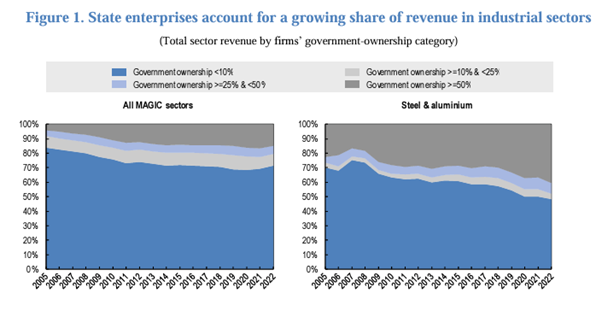New OECD Analysis Shows Growing Role of State Enterprises in Global Aluminum Market
Report Underscores China’s Unfair Advantages from State Ownership, Industrial Subsidies
A new report by the Organisation for Economic Cooperation and Development (OECD), Quantifying the role of state enterprises in industrial subsidies, finds that industrial subsidies like below-market finance tend to increase with the extent of state ownership, distorting global aluminum and other markets. The report also finds that state enterprises are more likely to benefit from favorable application of competition rules, public procurement practices and forced technology transfers.
Per the report: “The growing weight of [state enterprises] is especially visible in heavy industries such as steel and aluminium, where firms having 25% or more government ownership generated nearly half of all revenue among sampled firms in 2022.”
In welcoming the report, Charles Johnson, president & CEO of the Aluminum Association; Paul Voss, director general of European Aluminium; Jean Simard, president & CEO of the Aluminium Association of Canada; and Yasushi Noto, executive director of the Japan Aluminium Association said:
“We fully support all efforts by our governments to update multilateral trade rules and effectively address the non-market practices of state enterprises in global aluminum markets. We welcome the importance attributed by G7 Leaders in Apuli to advancing free and fair trade; strengthening the multilateral rule-based trading system, with the WTO at its core; and introducing new trade defense instruments, where necessary, to ensure a level playing field globally.
But until such time as there is a global level playing field and fair competition in aluminum markets, we urge governments to apply trade defense measures to enable the survival of our otherwise competitive industrial base.
On behalf of our member companies and the 1.75 million workers they directly and indirectly support across the United States, Europe, Canada, and Japan, we remain committed to working with governments and with international organizations to ensure widespread availability of responsibly and sustainably produced aluminum.”
The share of aluminum and steel firms by revenue with significant government ownership has grown at a faster rate than other sectors analyzed over the past two decades. This growth has been driven especially by firms based in China.

The new research highlights the role that state enterprises play as both major recipients of industrial subsidies and as major providers of such support. The analysis found that provision of below-market energy inputs by state utilities is common in some energy-rich countries, while below-market finance by state banks is a widespread subsidy instrument in China. This is an important new insight for governments striving to level the playing field and ensure fair competition globally.
The report notes that while state ownership is not problematic in and of itself, there is clear evidence that industrial subsidies, including below-market finance, tend to increase with the extent of state ownership. State enterprises are also more likely to benefit from favorable application of competition rules, public procurement practices, and forced technology transfers.
Provision of below-market energy inputs by state utilities is common in some energy-rich countries, while below-market finance by state banks is a widespread subsidy instrument in China. This is an important new insight for governments striving to level the playing field and ensure fair competition globally. The report notes: “Viewing government support as an ecosystem in which support flows in multiple directions and fundamentally reshapes markets poses challenges [to current approaches to multilateral rulemaking] but may open the way for more comprehensive solutions to the multiple market distortions engendered by support to and through state enterprises.”
Among other key takeaways from this and prior OECD studies:
- In a 2019 report, the OECD estimated that out of $70 billion provided to seventeen of the largest firms operating along the aluminum value chain from 2013 - 2017, 85% went to just five Chinese-owned firms (Chalco, China Hongqiao, QPIG, SPIC, China Zhongwang).
- Subsequent OECD analysis examined below-market finance provided by governments to 32 major aluminum companies. That report estimated support to range between 4-7% of the annual revenue of Chinese firms, compared to support of just 0.2% of the annual revenue of other firms.
- Over the past twenty years, as China’s share of global aluminum production grew from 8% to 58%, its share of the industry’s total CO2 emissions grew from 12% to 71%.
- Recent evidence for the steel and aluminum industries suggests that state subsidies act to increase firm-level CO2 emissions making such subsidies a significant contributor to CO2 emissions.
- The Chinese industrial sector borrows from the largest state-owned banks at a rate slightly above or even below the People’s Bank of China one-year key rate.
- The Chinese Government Guidance Funds, largely funded by government institutions and state enterprises, channel capital into industries that are considered strategic.
